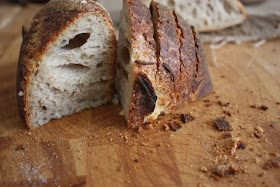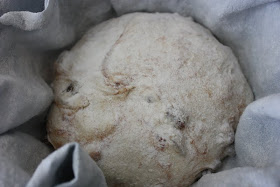reader, i'm hooked.
yesterday marked my first attempt at baguettes. actually, i didn't plan to make them. no, i struck out to make two of tartine's olive boules, because i'm back on track and following my experiment, linear like, see, as well a respectable gal should.
it is not with regret that i took this turn. i must avow that there's a good chance that it might have been premeditated. i kept fantasizing about how awesome it would be to have olive baguettes when none of l.a. could make the same claim. before i knew it, i had shaped the black studded dough into lancets, and cradled them within dusted hammocks to be born into my new addiction.
baguettes.
in tartine bread, chad robertson says that shaping baguette dough is difficult because you have to handle it much more than you do with other shapes. i wish i had read the text before forging headlong through the baguette frontier. evidently it is a highly evolved process that when undertook, yields impeccably tapered loaves, impossibly thin, with the crisped and pointed ends as sharp as scalpels that are all the rage in bread land.
chad also promises that practice makes perfect. and i want to believe him, desperately, because i imagine myself making baguettes so comely that they might make people swoon. chad's baguettes make people swoon.
my first born, i will admit, are the ugly children that only a mother could love. two, a little ashen, their slashes indecipherable, all of them more zaftig than chad's sleek and razor sharp spears. but no matter.
their crusts shattered like grandmother's good crystal would if the party got out of hand. and the crumb, oh the crumb. it was tender beyond explanation. open, briny, and fruity with slick, obsidian olives, fragrant of lemon and thyme.
there were four, but i ate one straight away, completely swaddled in bliss. one was shuttled off to my neighbor just a few doors beyond.
i feel a new love affair developing between bread and me. who knew that it could be even better than i've already come to know. my only regret in breaking my new plan to follow this book in linear fashion from beginning to end is that i didn't jump to the middle and make baguettes sooner.
Baguettes In Olive & Thyme
yesterday marked my first attempt at baguettes. actually, i didn't plan to make them. no, i struck out to make two of tartine's olive boules, because i'm back on track and following my experiment, linear like, see, as well a respectable gal should.
i should have included the disclaimer when announcing my good intentions a mere two posts previous, that i start to bite my nails when it comes to following rules. for instance, at the last minute today, olive dough enroute to becoming fabulous boules, these loaves next in queue, i found myself shaping the dough into baguettes instead. i couldn't help it. i was a woman possessed.
it is not with regret that i took this turn. i must avow that there's a good chance that it might have been premeditated. i kept fantasizing about how awesome it would be to have olive baguettes when none of l.a. could make the same claim. before i knew it, i had shaped the black studded dough into lancets, and cradled them within dusted hammocks to be born into my new addiction.
baguettes.
in tartine bread, chad robertson says that shaping baguette dough is difficult because you have to handle it much more than you do with other shapes. i wish i had read the text before forging headlong through the baguette frontier. evidently it is a highly evolved process that when undertook, yields impeccably tapered loaves, impossibly thin, with the crisped and pointed ends as sharp as scalpels that are all the rage in bread land.
chad also promises that practice makes perfect. and i want to believe him, desperately, because i imagine myself making baguettes so comely that they might make people swoon. chad's baguettes make people swoon.
my first born, i will admit, are the ugly children that only a mother could love. two, a little ashen, their slashes indecipherable, all of them more zaftig than chad's sleek and razor sharp spears. but no matter.
their crusts shattered like grandmother's good crystal would if the party got out of hand. and the crumb, oh the crumb. it was tender beyond explanation. open, briny, and fruity with slick, obsidian olives, fragrant of lemon and thyme.
there were four, but i ate one straight away, completely swaddled in bliss. one was shuttled off to my neighbor just a few doors beyond.
i feel a new love affair developing between bread and me. who knew that it could be even better than i've already come to know. my only regret in breaking my new plan to follow this book in linear fashion from beginning to end is that i didn't jump to the middle and make baguettes sooner.
Baguettes In Olive & Thyme
i used tartine's olive loaf recipe, which is slated to make two hefty boules. i adapted it by using fresh thyme instead of dried herbes de provence, and because i ran out of whole wheat flour, i used white whole wheat in its stead. i also omitted the toasted walnuts. i'll save those for another day.
200g levain (see below)
750g filtered h2o
900g KA bread flour
100g white whole wheat flour
340g olives
20g salt
1 TB fresh thyme leaves
zest of one large lemon
levain:
1 TB active 100% hydration starter (i'm using my trusted rye starter)
200g h2o
100g a/p flour
100g whole wheat flour
start the levain the night before you plan to bake the bread.
in a bowl large enough to accommodate a double growth of the ensuing levain, dissolve the starter with the h2o. mix in both flours. scrape down the sides of the bowl with a flexible dough scraper, cover the bowl with a towel, and put in a draft free place overnight. the next morning, the levain should have doubled and become quite billowy. it's ready to use. you may also use any remaining levain as your future starter. just feed it as you would your starter.
mixed the levain with 700g of water to dissolve. mixed in the flour and autolysed 40 minutes. mixed in the salt with 50g of water. rested 30 minutes. then did 4 series of turns at 30, 60, 90, 120 minutes (= 2. 5 hrs + 40 minutes autolyse so far). it's been quite hot here, so i finished the ferment (another 2.25 hours) in the fridge. shaped into 4 good-sized baguettes (or a semblance thereof), proofed in flour dusted couche: 2 loaves proofed for 2 hours, 2 proofed for 2.5 hours. oven preheat to 500 degrees, then turned down to 450 when i put the loaves in. i'm finding that 475, as chad calls for, has been too hot for my loaves and makes for scorched bottoms. maybe it's because I'm using cast iron instead of an actual baking stone. baked with steam* (on the cast iron griddle mentioned) for 15 minutes, then another 15-20 without steam till finished.
* my steam method: i misted the loaves with water heavily with a squirt bottle when i put them in the oven, then at 5 minute increments for the first 15 minutes. i also tossed cold water and ice into a hot skillet that i had placed in the bottom of the oven. finally, i misted the sides of the oven as well.
the good thing about baguettes vs. boules is that chad gives permission to eat them while warm, and so i did.
verdict:
crust: uber shattery. like glass. crumb: super tender and moist. very open. fragrant with herbs and olives. the lemon was imperceptible. i might zest two next time. difficulty in handling the dough: very easy. difficulty with proofing/fermenting: lately it's been hot, so i've found that doing a partial refrigerator ferment and/or proof has helped slow fermentation so that the loaves develop good flavor. i did not refrigerate the proofing baguettes. notes: i would increase the zest to 2 lemons worth, and add another teaspoon of fresh thyme. i would also read the section in tartine bread about shaping the loaves, or you might end up with fatties like mine.
to the staff of life!
this post has been sent off to wild yeast's yeast spotting.






































































